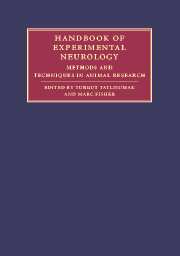Book contents
- Frontmatter
- Contents
- List of contributors
- Part I Principles and general methods
- 1 Introduction: Animal modeling – a precious tool for developing remedies to neurological diseases
- 2 Ethical issues, welfare laws, and regulations
- 3 Housing, feeding, and maintenance of rodents
- 4 Identification of individual animals
- 5 Analgesia, anesthesia, and postoperative care in laboratory animals
- 6 Euthanasia in small animals
- 7 Various surgical procedures in rodents
- 8 Genetically engineered animals
- 9 Imaging in experimental neurology
- 10 Safety in animal facilities
- 11 Behavioral testing in small-animal models: ischemic stroke
- 12 Methods for analyzing brain tissue
- 13 Targeting molecular constructs of cellular function and injury through in vitro and in vivo experimental models
- 14 Neuroimmunology and immune-related neuropathologies
- 15 Animal models of sex differences in non-reproductive brain functions
- 16 The ependymal route for central nervous system gene therapy
- 17 Neural transplantation
- Part II Experimental models of major neurological diseases
- Index
- References
10 - Safety in animal facilities
Published online by Cambridge University Press: 04 November 2009
- Frontmatter
- Contents
- List of contributors
- Part I Principles and general methods
- 1 Introduction: Animal modeling – a precious tool for developing remedies to neurological diseases
- 2 Ethical issues, welfare laws, and regulations
- 3 Housing, feeding, and maintenance of rodents
- 4 Identification of individual animals
- 5 Analgesia, anesthesia, and postoperative care in laboratory animals
- 6 Euthanasia in small animals
- 7 Various surgical procedures in rodents
- 8 Genetically engineered animals
- 9 Imaging in experimental neurology
- 10 Safety in animal facilities
- 11 Behavioral testing in small-animal models: ischemic stroke
- 12 Methods for analyzing brain tissue
- 13 Targeting molecular constructs of cellular function and injury through in vitro and in vivo experimental models
- 14 Neuroimmunology and immune-related neuropathologies
- 15 Animal models of sex differences in non-reproductive brain functions
- 16 The ependymal route for central nervous system gene therapy
- 17 Neural transplantation
- Part II Experimental models of major neurological diseases
- Index
- References
Summary
Introduction
The research animal facility is perhaps the most highly regulated area of interaction between humans and animals. Informing staff members and researchers of the risks posed by research animals is one of many expectations that must be met by institutions. Research animal facilities often house several different animal species. Each animal has a unique physiological, anatomical, and microbiological profile that affects its potential to harm personnel. The institutions are responsible for conveying information regarding research animal risks to large numbers of personnel and researchers with diverse backgrounds. The challenge of animal risk assessment is to select essential and easily understood information to help people who work with animals. Providing too little information to the researchers is unacceptable, but overwhelming detail is equally likely to miss the scientific target of experiments.
Laboratory animal facilities are simply a special type of laboratory. As a general principle, the biosafety level (facilities, practices, and operational requirements) recommended for working with infectious agents in vivo and in vitro are comparable with a microbiological laboratory where hazardous conditions are caused by personnel, and by the equipment. In the animal room, the activities of the animals themselves can present new hazards. Animals may generate aerosols, they may bite and scratch, and they may be infected with a zoonotic disease transferable from animals to humans.
General hazards
Since 1967 rodent breeding units have been recommended to be built behind a “barrier,” a so-called specific-pathogen-free (SPF) space separated from the main laboratory.
- Type
- Chapter
- Information
- Handbook of Experimental NeurologyMethods and Techniques in Animal Research, pp. 147 - 153Publisher: Cambridge University PressPrint publication year: 2006



